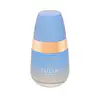What's inside
What's inside
 Key Ingredients
Key Ingredients

 Benefits
Benefits

 Concerns
Concerns

 Ingredients Side-by-side
Ingredients Side-by-side

Water
Skin ConditioningGlycerin
HumectantSqualane
EmollientPropanediol
SolventBetaine
HumectantMethylheptyl Isostearate
Skin ConditioningUndecane
EmollientSodium Acrylates Copolymer
Niacinamide
SmoothingPolyglyceryl-4 Caprate
EmulsifyingTulipa Hybrid Flower Extract
Skin ConditioningTerminalia Ferdinandiana Fruit Extract
AntioxidantAstragalus Membranaceus Root Extract
EmollientAtractylodes Macrocephala Root Extract
Skin ConditioningBupleurum Falcatum Root Extract
Skin ConditioningHydrolyzed Hyaluronic Acid
HumectantCholecalciferol
Tocopherol
AntioxidantAscorbyl Glucoside
AntioxidantAllantoin
Skin ConditioningSodium Citrate
BufferingSodium Hyaluronate
HumectantSodium Gluconate
Skin ConditioningSodium Lactate
BufferingXylitylglucoside
HumectantAnhydroxylitol
HumectantXylitol
HumectantLecithin
EmollientTridecane
PerfumingAcacia Senegal Gum
MaskingSucrose
HumectantZea Mays Starch
AbsorbentCaprylic/Capric Triglyceride
MaskingGluconolactone
Skin ConditioningSodium Benzoate
MaskingCaprylyl Glycol
EmollientPotassium Sorbate
PreservativePhenethyl Alcohol
MaskingCalcium Gluconate
HumectantCitric Acid
BufferingSodium Hydroxide
BufferingMica
Cosmetic ColorantTitanium Dioxide
Cosmetic ColorantWater, Glycerin, Squalane, Propanediol, Betaine, Methylheptyl Isostearate, Undecane, Sodium Acrylates Copolymer, Niacinamide, Polyglyceryl-4 Caprate, Tulipa Hybrid Flower Extract, Terminalia Ferdinandiana Fruit Extract, Astragalus Membranaceus Root Extract, Atractylodes Macrocephala Root Extract, Bupleurum Falcatum Root Extract, Hydrolyzed Hyaluronic Acid, Cholecalciferol, Tocopherol, Ascorbyl Glucoside, Allantoin, Sodium Citrate, Sodium Hyaluronate, Sodium Gluconate, Sodium Lactate, Xylitylglucoside, Anhydroxylitol, Xylitol, Lecithin, Tridecane, Acacia Senegal Gum, Sucrose, Zea Mays Starch, Caprylic/Capric Triglyceride, Gluconolactone, Sodium Benzoate, Caprylyl Glycol, Potassium Sorbate, Phenethyl Alcohol, Calcium Gluconate, Citric Acid, Sodium Hydroxide, Mica, Titanium Dioxide
Ingredients Explained
These ingredients are found in both products.
Ingredients higher up in an ingredient list are typically present in a larger amount.
Caprylyl Glycol is a humectant and emollient, meaning it attracts and preserves moisture.
It is a common ingredient in many products, especially those designed to hydrate skin. The primary benefits are retaining moisture, skin softening, and promoting a healthy skin barrier.
Though Caprylyl Glycol is an alcohol derived from fatty acids, it is not the kind that can dry out skin.
This ingredient is also used as a preservative to extend the life of products. It has slight antimicrobial properties.
Learn more about Caprylyl GlycolGluconolactone is a PHA. PHAs are a great gentle alternative to traditional AHAs.
When applied, Gluconolactone has the same affect on skin as AHAs such as lactic acid. It helps dissolve the dead skin cells in the top layer of your skin. This improves texture and brightens the skin.
PHAs are more gentle than AHAs due to their larger structure. They do not penetrate as deeply as AHAs and take a longer time to dissolve dead cells. Studies show PHAs do not cause as much irritation.
Gluconolactone has some interesting properties:
In a 2004 study, Gluconolactone was found to prevent UV damage in mouse skin cells and has not been found to increase sun sensitivity. However, we still recommend wearing SPF daily.
This ingredient is is an created by reacting gluconic acid with an alcohol.
Learn more about GluconolactoneSodium Hyaluronate is hyaluronic acid's salt form. It is commonly derived from the sodium salt of hyaluronic acid.
Like hyaluronic acid, it is great at holding water and acts as a humectant. This makes it a great skin hydrating ingredient.
Sodium Hyaluronate is naturally occurring in our bodies and is mostly found in eye fluid and joints.
These are some other common types of Hyaluronic Acid:
Learn more about Sodium HyaluronateSodium Hydroxide is also known as lye or caustic soda. It is used to adjust the pH of products; many ingredients require a specific pH to be effective.
In small amounts, sodium hydroxide is considered safe to use. However, large amounts may cause chemical burns due to its high alkaline.
Your skin has a natural pH and acid mantle. This acid mantle helps prevent harmful bacteria from breaking through. The acid mantle also helps keep your skin hydrated.
"Alkaline" refers to a high pH level. A low pH level would be considered acidic.
Learn more about Sodium HydroxideSodium Lactate is the sodium salt of lactic acid, an AHA. It is a humectant and sometimes used to adjust the pH of a product.
This ingredient is part of our skin's NMF, or natural moisturizing factor. Our NMF is essential for the hydration of our top skin layers and plasticity of skin. NMF also influences our skin's natural acid mantle and pH, which protects our skin from harmful bacteria.
High percentages of Sodium Lactate can have an exfoliating effect.
Fun fact: Sodium Lactate is produced from fermented sugar.
Learn more about Sodium LactateWater. It's the most common cosmetic ingredient of all. You'll usually see it at the top of ingredient lists, meaning that it makes up the largest part of the product.
So why is it so popular? Water most often acts as a solvent - this means that it helps dissolve other ingredients into the formulation.
You'll also recognize water as that liquid we all need to stay alive. If you see this, drink a glass of water. Stay hydrated!
Learn more about Water